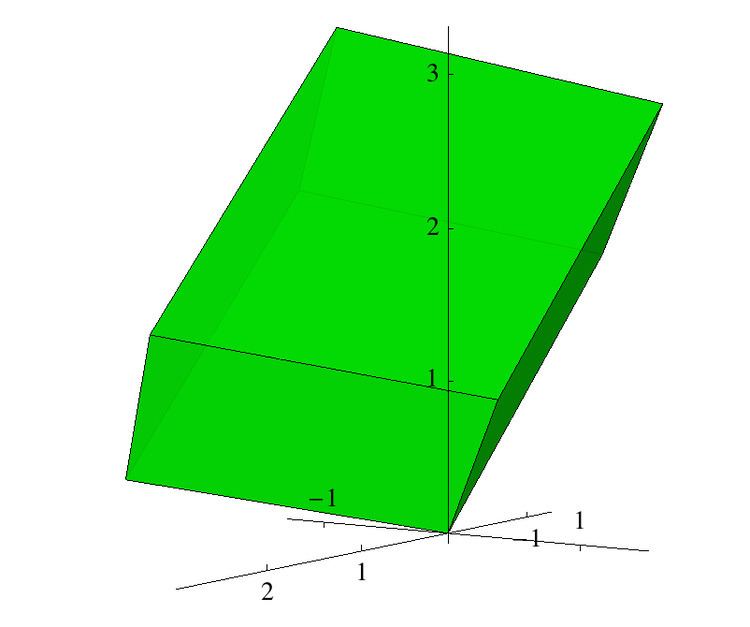 | ||
In mathematics, the discriminant of an algebraic number field is a numerical invariant that, loosely speaking, measures the size of the (ring of integers of the) algebraic number field. More specifically, it is proportional to the squared volume of the fundamental domain of the ring of integers, and it regulates which primes are ramified.
Contents
- Definition
- Examples
- Basic results
- History
- Relative discriminant
- Ramification
- Root discriminant
- Relation to other quantities
- References
The discriminant is one of the most basic invariants of a number field, and occurs in several important analytic formulas such as the functional equation of the Dedekind zeta function of K, and the analytic class number formula for K. An old theorem of Hermite states that there are only finitely many number fields of bounded discriminant, however determining this quantity is still an open problem, and the subject of current research.
The discriminant of K can be referred to as the absolute discriminant of K to distinguish it from the relative discriminant of an extension K/L of number fields. The latter is an ideal in the ring of integers of L, and like the absolute discriminant it indicates which primes are ramified in K/L. It is a generalization of the absolute discriminant allowing for L to be bigger than Q; in fact, when L = Q, the relative discriminant of K/Q is the principal ideal of Z generated by the absolute discriminant of K.
Definition
Let K be an algebraic number field, and let OK be its ring of integers. Let b1, ..., bn be an integral basis of OK (i.e. a basis as a Z-module), and let {σ1, ..., σn} be the set of embeddings of K into the complex numbers (i.e. injective ring homomorphisms K → C). The discriminant of K is the square of the determinant of the n by n matrix B whose (i,j)-entry is σi(bj). Symbolically,
Equivalently, the trace from K to Q can be used. Specifically, define the trace form to be the matrix whose (i,j)-entry is TrK/Q(bibj). This matrix equals BTB, so the discriminant of K is the determinant of this matrix.
Examples
Basic results
History
The definition of the discriminant of a general algebraic number field, K, was given by Dedekind in 1871. At this point, he already knew the relationship between the discriminant and ramification.
Hermite's theorem predates the general definition of the discriminant with Charles Hermite publishing a proof of it in 1857. In 1877, Alexander von Brill determined the sign of the discriminant. Leopold Kronecker first stated Minkowski's theorem in 1882, though the first proof was given by Hermann Minkowski in 1891. In the same year, Minkowski published his bound on the discriminant. Near the end of the nineteenth century, Ludwig Stickelberger obtained his theorem on the residue of the discriminant modulo four.
Relative discriminant
The discriminant defined above is sometimes referred to as the absolute discriminant of K to distinguish it from the relative discriminant ΔK/L of an extension of number fields K/L, which is an ideal in OL. The relative discriminant is defined in a fashion similar to the absolute discriminant, but must take into account that ideals in OL may not be principal and that there may not be an OL basis of OK. Let {σ1, ..., σn} be the set of embeddings of K into C which are the identity on L. If b1, ..., bn is any basis of K over L, let d(b1, ..., bn) be the square of the determinant of the n by n matrix whose (i,j)-entry is σi(bj). Then, the relative discriminant of K/L is the ideal generated by the d(b1, ..., bn) as {b1, ..., bn} varies over all integral bases of K/L. (i.e. bases with the property that bi ∈ OK for all i.) Alternatively, the relative discriminant of K/L is the norm of the different of K/L. When L = Q, the relative discriminant ΔK/Q is the principal ideal of Z generated by the absolute discriminant ΔK . In a tower of fields K/L/F the relative discriminants are related by
where
Ramification
The relative discriminant regulates the ramification data of the field extension K/L. A prime ideal p of L ramifies in K if, and only if, it divides the relative discriminant ΔK/L. An extension is unramified if, and only if, the discriminant is the unit ideal. The Minkowski bound above shows that there are no non-trivial unramified extensions of Q. Fields larger than Q may have unramified extensions, for example, for any field with class number greater than one, its Hilbert class field is a non-trivial unramified extension.
Root discriminant
The root discriminant of a number field, K, of degree n, often denoted rdK, is defined as the n-th root of the absolute value of the (absolute) discriminant of K. The relation between relative discriminants in a tower of fields shows that the root discriminant does not change in an unramified extension. The existence of a class field tower provides bounds on the root discriminant: the existence of an infinite class field tower over Q(√-m) where m = 3·5·7·11·19 shows that there are infinitely many fields with root discriminant 2√m ≈ 296.276. If we let r and 2s be the number of real and complex embeddings, so that n = r + 2s, put ρ = r/n and σ = 2s/n. Set α(ρ, σ) to be the infimum of rdK for K with (r', 2s') = (ρn, σn). We have (for all n large enough)
and on the assumption of the generalized Riemann hypothesis
So we have α(0,1) < 296.276. Martinet has shown α(0,1) < 93 and α(1,0) < 1059. Voight 2008 proves that for totally real fields, the root discriminant is > 14, with 1229 exceptions.
